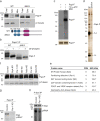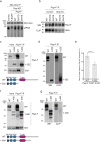Siwi cooperates with Par-1 kinase to resolve the autoinhibitory effect of Papi for Siwi-piRISC biogenesis
- PMID: 35314687
- PMCID: PMC8938449
- DOI: 10.1038/s41467-022-29193-9
Siwi cooperates with Par-1 kinase to resolve the autoinhibitory effect of Papi for Siwi-piRISC biogenesis
Abstract
Bombyx Papi acts as a scaffold for Siwi-piRISC biogenesis on the mitochondrial surface. Papi binds first to Siwi via the Tudor domain and subsequently to piRNA precursors loaded onto Siwi via the K-homology (KH) domains. This second action depends on phosphorylation of Papi. However, the underlying mechanism remains unknown. Here, we show that Siwi targets Par-1 kinase to Papi to phosphorylate Ser547 in the auxiliary domain. This modification enhances the ability of Papi to bind Siwi-bound piRNA precursors via the KH domains. The Papi S547A mutant bound to Siwi, but evaded phosphorylation by Par-1, abrogating Siwi-piRISC biogenesis. A Papi mutant that lacked the Tudor and auxiliary domains escaped coordinated regulation by Siwi and Par-1 and bound RNAs autonomously. Another Papi mutant that lacked the auxiliary domain bound Siwi but did not bind piRNA precursors. A sophisticated mechanism by which Siwi cooperates with Par-1 kinase to promote Siwi-piRISC biogenesis was uncovered.
© 2022. The Author(s).
Conflict of interest statement
The authors declare no competing interests.
Figures




Similar articles
-
Siwi levels reversibly regulate secondary piRISC biogenesis by affecting Ago3 body morphology in Bombyx mori.EMBO J. 2020 Oct 15;39(20):e105130. doi: 10.15252/embj.2020105130. Epub 2020 Sep 11. EMBO J. 2020. PMID: 32914505 Free PMC article.
-
DEAD-box polypeptide 43 facilitates piRNA amplification by actively liberating RNA from Ago3-piRISC.EMBO Rep. 2021 Apr 7;22(4):e51313. doi: 10.15252/embr.202051313. Epub 2021 Feb 8. EMBO Rep. 2021. PMID: 33555135 Free PMC article.
-
Maelstrom functions in the production of Siwi-piRISC capable of regulating transposons in Bombyx germ cells.iScience. 2022 Feb 11;25(3):103914. doi: 10.1016/j.isci.2022.103914. eCollection 2022 Mar 18. iScience. 2022. PMID: 35243263 Free PMC article.
-
piRNAs: biogenesis and their potential roles in cancer.Cancer Metastasis Rev. 2020 Jun;39(2):567-575. doi: 10.1007/s10555-020-09863-0. Cancer Metastasis Rev. 2020. PMID: 31960205 Review.
-
Piwi-interacting RNAs: biological functions and biogenesis.Essays Biochem. 2013;54:39-52. doi: 10.1042/bse0540039. Essays Biochem. 2013. PMID: 23829526 Review.
Cited by
-
Bombyx Vasa sequesters transposon mRNAs in nuage via phase separation requiring RNA binding and self-association.Nat Commun. 2023 Apr 7;14(1):1942. doi: 10.1038/s41467-023-37634-2. Nat Commun. 2023. PMID: 37029111 Free PMC article.
-
A model that integrates the different piRNA biogenesis pathways based on studies in silkworm BmN4 cells.Curr Res Insect Sci. 2025 Feb 11;7:100108. doi: 10.1016/j.cris.2025.100108. eCollection 2025. Curr Res Insect Sci. 2025. PMID: 40083348 Free PMC article. Review.
References
Publication types
MeSH terms
Substances
LinkOut - more resources
Full Text Sources
Molecular Biology Databases

